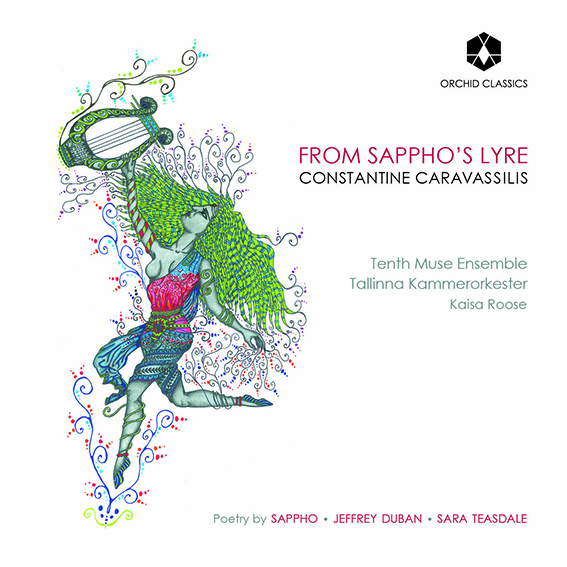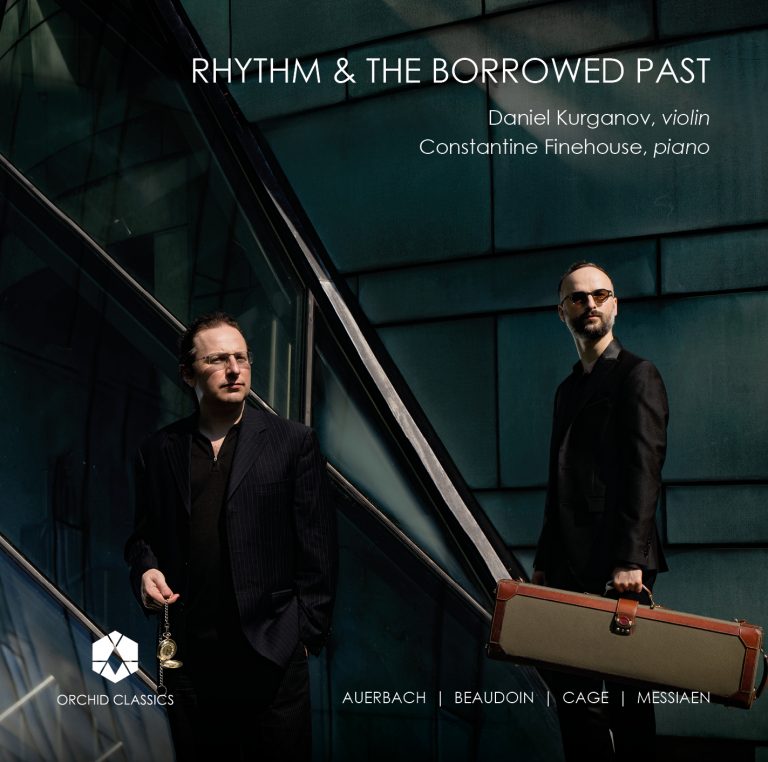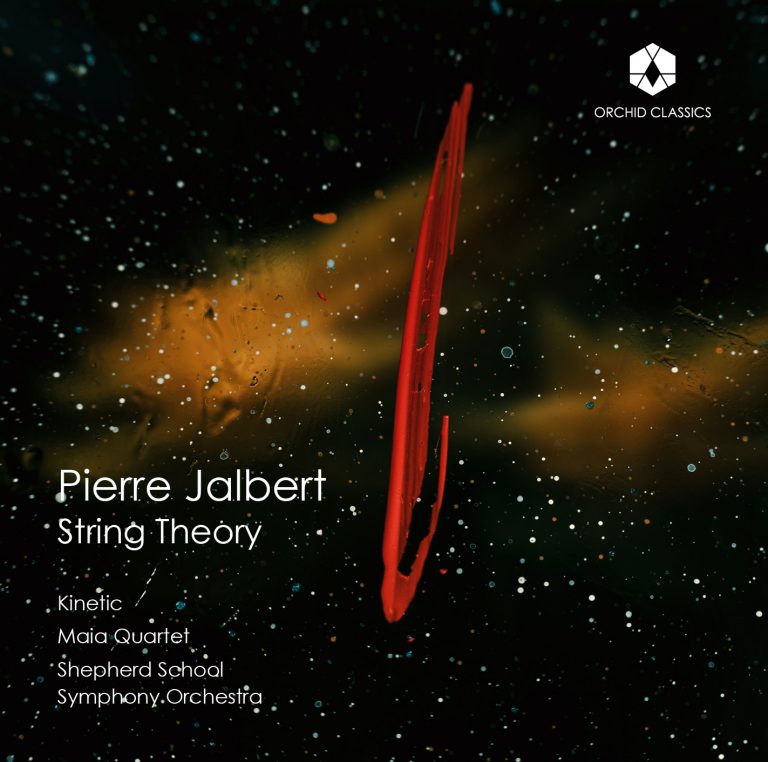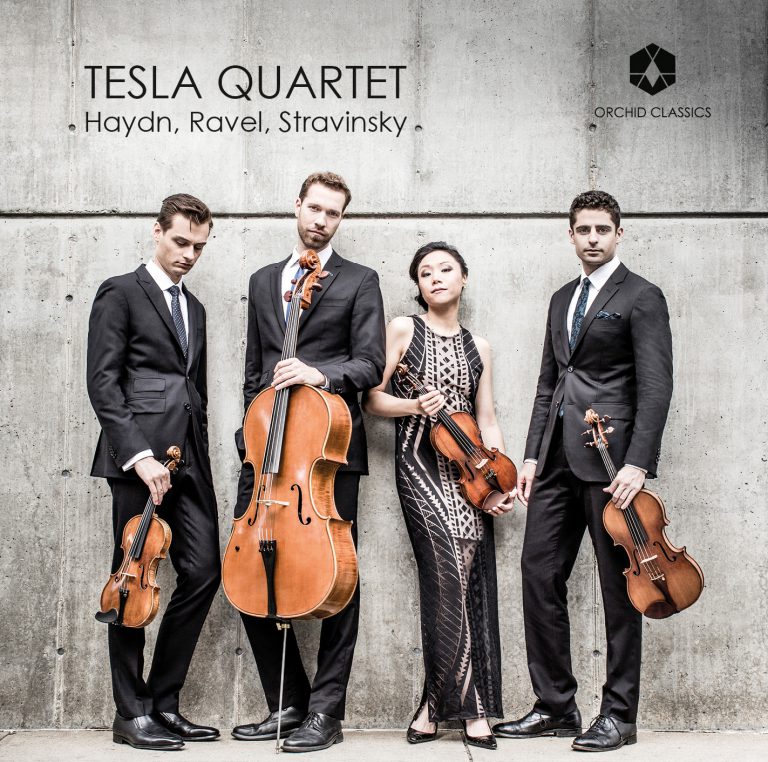Artist Led, Creatively Driven

From Sappho’s Lyre
Constantine Caravassilis
Tenth Muse Ensemble
Tallinna Kammerorkester
Kaisa Roose
Release Date: 20th October
ORC100260
DISC 1
From Sappho’s Lyre
Part A: Hymn to Aphrodite
1. I The Goddess Awakened
2. II Earthward Summoned
3. III Double Aria
4. IV Fantasy (Chorale)
5. V Pas de deux
6. VI Incantation (Air)
7. VII Choros: Deathless Aphrodite
Part B: Equal to the Gods (He Appears to Me)
8. VIII Invocation
9. IX Rapture
10. X Seduction (Aria)
11. XI Conveyance (Ancient Bazaar)
12. XII Cosmic Canticle
13. XIII Aegean Recitative
14. XIV Zenith (Aria)
15. XV Dream Within
16. XVI Apotheosis
17. XVII Exodos
Liana Guberman-Chriss, soprano
Carla Jablonski, mezzo soprano
Daniel Moody, countertenor
Jeffrey M. Duban, narrator
Constantine Caravassilis, conductor
Tenth Muse Ensemble (Abigel Kralik, violin; Madeline Fayette, cello; Anna Urrey, flute/alto flute/piccolo; Noemi Sallai, clarinet/bass clarinet; Louise Ollivier, harp; Jess Tsang, percussion; Amin Reihani, santour; Maria Pikoula, piano. Chorus: Elizabeth van Os, Aine Hakamatsuka, Jenni Klauder, Daniel Moody, Nathan Hodgson, Jason Weisinger, Paul Holmes & Brian Mummert)
DISC 2
Five Duban Songs: Eros Sanctified
1. I The Gazing Gossamer
2. II Explore Me
3. III Doting Daphnis
4. IV Lalagē
5. V Communion
Ariana Chris, mezzo soprano
Tallinna Kammerorkester
Kaisa Roose, conductor
My Life a Lyric Cry
6. I-II Twilight
7. III-IV Cried to Love
8. V-VI I Have Pierced the Pain
9. VII-VIII Beneath thy Perfect Feet
10. IX-X My Life a Lyric Cry
Jenni Klauder, soprano
Sophie Shao, cello
Katherine Needleman, oboe/English horn
Jeffrey M. Duban, narrator
Maria Pikoula, piano
Sappho de Mytilène
11. I Mon Chant
12. II Toujours Eros
13. III Vièrge
14. IV Adonis
15. V Messager du Printemps
Ariana Chris, mezzo soprano
Anna Urray, flute/alto flute
Maria Pikoula, piano
From Sappho’s Lyre (by Constantine Caravassilis)
From Sappho’s Lyre is a multimedia, scenic cantata for large chamber ensemble based on Sappho’s two major surviving poems: “The Hymn to Aphrodite” and “He Appears to Me (Equal to the Gods).”
Conceived as a stage work to be accompanied by dance and spectacle—and though it can be performed as a traditional vocal work with instrumental accompaniment—the composition’s overall formal/architectural design functions as a hybrid, one that lavishly fuses elements of ancient Greek play and theatre with Western ballet and opera.
Scored for two solo voices (soprano and mezzo), chamber orchestra, chamber choir, pre-recorded audio, and narrator, From Sappho’s Lyre is based on—and heavily inspired by—The Lesbian Lyre: Reclaiming Sappho for the 21st Century, a groundbreaking book by classicist Jeffrey M. Duban (Clairview Books, 2016). It uses the author’s translations to portray, interpret, and dramatize the charm and elegance of the originals so magnificently conveyed in the English language, while offering the listener a journey that orbits around ever evolving and shifting sonic and visual realms.
Antiquity’s Poetess and Ours (by Jeffrey M. Duban) sleeve note excerpt
Sappho’s Lesbos—well wooded, well cultivated, and well populated—lay within several hours of Sardis, the sophisticated capital of the wealthy kingdom of Lydia (in Asia Minor, modern Turkey). The island was active in seventh-century trade and colonization; it was torn by bouts of factionalism and political upheaval to which the aristocratic Sappho was sometimes prey, although her poetry reflects little of this. Indeed, as Aphrodite is Sappho’s special goddess and is herself apolitical among the contentious gods, so is Sappho’s poetry apolitical. The women of Lesbos were famed for their beauty no less than for their sophistication. Beauty contests were a yearly event.
Ancient criticism of Sappho finds its consensus in her poetic supremacy. In epigrams from the Palatine Anthology she is regularly counted as the tenth of the Muses: “Memory [mother of the Muses] herself was astonished when she heard the honey-sweet Sappho, wondering whether mankind possessed a tenth Muse.” Sappho is deemed “the equal of any god” and the ultimate in her craft: “You have established the beginning and end of all lyric song.” Also counting Sappho among the Muses, the Greek historian and biographer Plutarch (46 -120 AD) elaborates: “Sappho utters words truly mingled with fire and gives vent through her song to the heat that consumes her heart.” In so doing, she is said to “heal the pain of love with the Muses’ melody.” Again, in the Palatine Anthology, she is considered “sweetest of love-pillows to the burning young,” a companion to Hymen, god of weddings at the bridal bed, and to Aphrodite lamenting Adonis in the sacred grove of the blessed.
Sappho was derided as well as praised in antiquity—the former when the concern focused on her sexuality rather than on her poetry. The Greek comic playwrights of the fourth century BC were particularly unsparing (and influential), however much their works are known in merest fragments or by title alone. A key source is the Roman poet Ovid (43BC – 18AD), who espouses both sides of the issue, thus doing little to resolve it. Ovid asks, “What did Sappho of Lesbos teach but how to love maidens? Yet Sappho herself was safe.” By ‘safe’ (tuta) Ovid apparently means that Sappho condoned, without herself practicing, homosexuality. Ovid’s position is at variance with the view taken in his famed “Sappho-Phaon Epistle”:
Not Pyrrha’s coterie nor Methymna’s girls beguile me now, nor any Lesbian maiden. Dazzling Cydro’s of no account—Anactoria and Atthis, once embraced, are now disdained; and the hundred others, loved to my reproach, relinquished this their claim to callous you [Phaon] alone.
The rhetorician-philosopher Maximus of Tyre (2d century AD) in an equally famous statement takes a more elevated view:
But is not love of the Lesbian poetess (if one can compare older with more recent) in fact identical with Socrates’ amatory art? It seems to me that each of them pursued a particular kind of affection, for women in the one case and men in the other. Both claimed to have many beloveds, and to be captivated by anyone who was beautiful. What Alcibiades, Charmides, and Phaedrus were to the one, Gyrinna, Atthis, and Anactoria were to the poetess of Lesbos.
Forests have fallen for the writing addressed to this comparison. We may for the present note that much of Sappho’s surviving work is ambiguous about the type of love involved and, for that reason the more interesting. The love that Sappho’s Aphrodite controls may be heterosexual or lesbian. Both types find expression in Sappho’s work and life. The goddess is as responsible for Helen’s adultery with Paris as she is for the departure of Sappho’s beloved to Lydia. Virginity is a cherished state, but not to be cultivated. Though its loss may be painful, marriage and the handsomeness of the groom find ready praise. Sappho’s longest surviving work is a narrative poem celebrating the wedding of Hector and Andromache—Hector the principal defender of Troy. From what we may surmise, Sappho was married and had a daughter named Cleis, though both points are disputable. According to Ovid (our primary source for the legend), Sappho ended her life in a suicidal leap for unrequited love of the ferryman Phaon.
An unrivaled female poet and lover of women in a man’s world—where male poets typically wrote of homoerotic loves—Sappho has in turn been admired, derided, moralized, analogized and, in her despair of a heterosexual rebuff, allegedly driven to suicide in a far-off and undistinguished island locale. The analogy to Socrates intellectualizes—even as it seeks to redeem—Sappho’s love of women, placing it on par with the love of man for man, as propounded and practiced by the wisest man of all. It is, however, in the analogy to Aphrodite that Sappho transcends the mortal fray—its partisanship and judgmentalism—making of self-ideation a masterstroke of genius.
Constantine Caravassilis
Driven by beauty and spirituality; inspired by literature, nature, the music of the spheres and imagined workings of the cosmos; reflecting a deep humanitarianism and modern findings on the faculties of the human brain, Constantine Caravassilis’ work is yet intimately connected to his Hellenic roots. Caravassilis draws inspiration from the prodigious past and supreme wisdom of his ancestors, as he reflects on Greek mythology and epic themes and on Byzantine chant and the times it reflects. And yet, he often finds himself re-imagining Eastern modality and the folksongs of the Aegean as sung to him by his grandmothers.
Born to a musical family in Toronto, Canada, he was raised in Pythagorion, a culturally rich town on the Greek Island of Samos, off the coast of Asia Minor—the birthplace of the mathematician Pythagoras and philosopher Epicurus. While studying Western music, his influences prominently included a playground atop marble mosaics; ruins from Archaic, Classical, Hellenistic and Roman times; the proximity of ancient engineering wonders such as the Eupalinian aqueduct, the “Eighth Wonder of the Ancient World” (6th century BC); the protective castle walls of the tyrant Polycrates; and the scents, icons, and vestments of the nearby orthodox churches and monasteries, not to omit the taste of sweet Muscat wine.
Since his mid-twenties, Constantine has been a fresh and forceful compositional voice, with international exposure through hundreds of performances and broadcasts in such venues as Carnegie Hall (New York), Jordan Hall (Boston), Southam Hall (Ottawa), Bunka-Kaikan Hall (Tokyo), AlteOper (Frankfurt), Rundetårn (Copenhagen), Smolensk Philharmonic (Russia), the Athens and Thessaloniki Concert Halls (Megara), and Palácio Foz (Lisbon), to name the more prominent. In 2006, his work Baroque Revisited—incidental music written for a documentary on J. S. Bach’s Goldberg Variations—was toured in more than 40 American states. His music has been performed in Canada, the United States, Mexico, Argentina, Brazil, Peru, Great Britain, Spain, Portugal, Germany, France, Belgium, the Netherlands, Denmark, Croatia, Poland, Italy, Romania, Austria, Belarus, Estonia, Lithuania, Ukraine, Russia, Greece, Cyprus, Turkey, Israel, Hong Kong, and Japan.
Although primarily a composer—among the most prolific of his generation—Constantine has long been active as both pianist and conductor. He has led multiple ensembles in recording sessions and live concerts, including the Contemporary Music Ensembles of the Universities of Toronto and Manitoba, Opera 5, the Toronto Concert Orchestra, Concert:Nova in Cincinnati, the Out of this World Orchestra, the Tenth Muse Ensemble in New York, and the Roma Tre Orchestra in Italy.
Jazz & Tzaz music magazine hails him “the most important Hellenic-descent composer of his generation,” the Toronto Star calls his music “timeless,” while Ludwig van Toronto states that Caravassilis writes “music that earns our attention rather than requiring it.” Barzablog calls his music “visionary”; Jon Gonder of the CALM Review comments on Caravassilis’ solo piano works: “These are not the rhapsodies of Brahms or Bartok. Caravassilis’ approach to form is more rhapsodic in spirit than either of those masters.” Trillonquy claims that his music is “visually pleasing; no one dares move, incredible!” while Jason Victor Sernius of Stereophile Magazine states (in his review of Caravassilis’ guitar concerto): “I can’t get enough of Saudade’s mysterious, wistful beauty, with iridescent touches punctuated by deep bass and fascinating percussion.”
A graduate of the reputed composition program of the University of Toronto, where he studied on a full fellowship, Constantine holds a Doctor of Musical Arts degree from the same institution. He has been awarded several top honours, including the Karen Kieser Prize in Canadian Music, the Harry Freedman Recording Award, the Epikouros Arts and Letters Award, and three gold medals at the Volos International Composition Competition for his “profoundly mature style and highly individual compositional voice.” In addition to several academic scholarships, Constantine has received numerous commissioning, travel, career development, and recording grants from the Toronto, Ontario, and Canada Arts Councils, the British Arts Council, the Winnipeg Arts Council, and Hereford Arts (NYC).
Jeffrey M. Duban
Jeffrey Duban attended the Boston Public Latin School, where he began his study of Latin in the seventh grade and classical Greek in the tenth. Graduating from Brown University with a combined B.A.-M.A. in classics, he went on to complete his Ph.D in classical philology at The Johns Hopkins University. After receiving his Ph.D., Duban served for seven years as a professor of classics at the Ohio and Georgia State universities, teaching, publishing scholarly articles, and serving as poetry editor for the Classical Outlook. During that time, he translated Orff’s Carmina Burana for the Atlanta Symphony Orchestra’s subscription concerts at the invitation of the orchestra’s then conductor, Robert Shaw. Duban’s libretto accompanied Shaw’s original recording on the Telarc label.
After teaching, Mr. Duban enrolled in law school, obtaining his JD degree from the Fordham Law School. As an attorney, he specialized in academic law, defending professors in promotion and tenure disputes, and professors and students alike in racial discrimination and sexual misconduct cases.
Mr. Duban is the author of The Lesbian Lyre: Reclaiming Sappho for the 21st Century (2016) and The Shipwreck Sea: Love Poems and Essays in a Classical Mode (2019), both publications of Clairview Books (UK), Sevak Gulbekian, Chief Editor. An avid supporter of the arts, Mr. Duban has also produced and narrated the musical programs “Sappho, Nine Fragments for Contralto” by Sir Granville Bantock, and “Sappho for Soprano” with music by prominent composers on Sapphic themes, including Caravassilis’ “My Life a Lyric Cry.”
Tallinna Kammerorkester
The Tallinn Chamber Orchestra (TCO) was founded in 1993 by Estonian conductor Tõnu Kaljuste and has since become one of Estonia’s signature orchestras performing on numerous stages and all over the world. Its diverse repertoire includes music from the Baroque to works of the composers of the 20th and 21st centuries.
The TCO has worked closely with the Estonian Philharmonic Chamber Choir for decades. Their joint performances and recordings have gained international fame and recognition starting in 1993 with Tõnu Kaljuste leading the recording of Arvo Pärt’s Te Deum for ECM Records. Under ECM, the TCO has subsequently released several other records including Pärt’s Litany, In Principio and Adam’s Lament, Erkki-Sven Tüür’s Crystallisatio and Heino Eller’s Neenia. The TCO has also recorded for Warner Music, Finlandia Records, Carus Verlad, Ondine, and Orchid.
Its recording of Tõnu Kõrvits’ Lageda laulud (Moorland Elegies) in collaboration with the Estonian Philharmonic Choir under the direction of Risto Joost was awarded the Classics Album of the Year at the 2018 Estonian Music Awards.
The TCO has performed in many prestigious music festivals such as the MITO SettembreMusica and Festival Arturo Benedetti Michelangeli in Italy, the MDR Musiksommer in Germany, the Budapest Autumn Festival, the Naantali and Musiikkia! festivals in Finland, Festival Cervantino in Mexico, the Vale of Glamorgan Festival in Wales and the Euphonie in Poland. Concert tours have taken the orchestra to the USA, Canada, Japan, China, Brazil, Argentina, Mexico and to most European countries. The TCO has performed in some of the world’s most important venues including Elbphilharmonie in Hamburg, Carnegie Hall in New York City and the Forbidden City Concert Hall in Beijing.
In 2013, the TCO received the Estonia Music Council’s Prize for Interpretation. In 2014, the orchestra participated in a recording of Arvo Pärt’s Adam’s Lament which earned its conductor Tõnu Kaljuste a Grammy. Tõnu Kaljuste was the orchestra’s first chief conductor in 1993-1995 and 1996-2001. Juha Kangas collaborated with the orchestra as the chief conductor in 1995-1996 and as artistic adviser in 2001-2003. The following decade was curated by Tallinn Philharmonic Society’s artistic director Eri Klas. In 2013-2019 the chief conductor of TCO was Risto Joost. In 2019, the TCO welcomed back Tõnu Kaljuste as its chief conductor.
Tenth Muse Ensemble
The Tenth Muse Ensemble—named for Sappho, whom Plato considered the “tenth Muse”—was hand-chosen by composer-conductor Constantine Caravassilis to meet the special requirements of his monumental “From Sappho’s Lyre.” His New York City-based collaborators provided him with the names of dozens of city musicians whose performance work was personally known to them. In one case, Caravassilis himself found—and was fortunate to engage—one of the vocal soloists while attending a New York City performance of Carmina Burana. Each ensemble member is a graduate of a top musical institution—mostly Juilliard and Curtis—and has a confirmed level of performance excellence and recognition, including sterling reviews, honors, and awards.
After personally selecting each musician, Caravassilis then provided them with samples of his music to learn, record, and return to him in audio format, whereupon he “reshaped” key sections of the work to fit each musician’s or vocalist’s individual manner. It was clear from the first rehearsal that the choices were ideal, as the ensemble came immediately together, making it possible to start recording “takes” from the outset.









